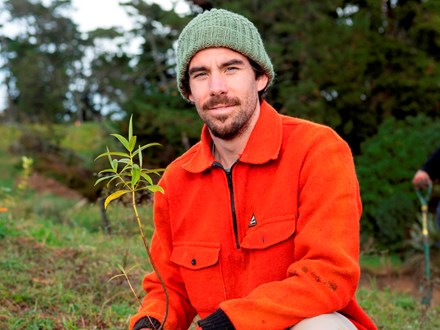What's left is curiosity and questions. How should we live to ensure health for ourselves and our natural environments?
When I was 21 I took a job at a native plant nursery to follow my curiosity about this question. I got to work with plants for the first time. I was introduced to Tōtara, Nikau, Kauri, and Kahikatea. I saw thousands of young plants come and go through the yard and I wanted to go where I imagined they were going. To grow in the forest. I took the long way round via a Bachelor's Degree, majoring in Biodiversity Management. During this time my interests still centred around imagining a positive role for humans in nature.
The science of ecology spoke of relationships, dynamic flows, symbiosis and competition. These concepts brought life to the forest. They also felt relatable to human social interactions. Unfortunately for me, the applied practice of conservation lacked a positive narrative of humans. We were destructive pests. We needed to be excluded from the pristine natural environment. I understood the need for the protection of threatened species and ecosystems. But I still yearned for a better understanding of how to interact with nature in a positive way. I wanted to know how to live within its limits, to be a part of the ecosystem, not its curator.
After graduating, I applied my learning through a hands-on conservation job focused on forest revegetation. I was excited at the prospect of playing a regenerative role in the ecosystem. I wanted to further explore my questions about living with nature by connecting and learning directly from the source. I did enjoy being outdoors. I liked planting trees and witnessing the forest return to previously degraded landscapes.
Unfortunately, there was the competitive nature of the industry. This meant everything was performed at pace. This left little time to connect.
There were so many contradictions in the way we approached this work. We waged chemical warfare on every species that was not native. This ignored their potential utility in healing the degraded landscape. These methods were detrimental to human and soil health. They slowed the landscape healing process and were very expensive. Our herbicides use required full length clothing, thick gloves, respirators, earmuffs and safety goggles. This further disconnected us from our surroundings.
I had spent nearly a decade of following our society's most nature oriented education and career pathways. But I was no closer to understanding my place in the ecosystem.
That only came recently, working closely with Te Pu-a-Nga Maara (TPNM) and the Awa Rangers on the Puhinui. I started to find the wisdom I had been looking for all along.
One of TPNM’s purposes is to revive maatauranga approaches to mahi tiaki taiao (nature based work). I've been lucky to be introduced to the stories and songs that personify natural phenomena. They teach us, through dramas played out in the landscape and our imaginations. I've also been slowly learning tikanga. These protocols inform behaviour towards reciprocity with te taiao and towards wellbeing.
When applied on the whenua, these concepts and tikanga manifest as practices that regenerate te taiao, as well as those involved. The place of revegetation is considered by TPNM to be the healing edge of the old forest. This regenerates the whenua from its degraded state.
Simply being in that space has wellbeing inducing effects, if treated property. TPNM ensures this is the case by intentionally making this a healthy space. No herbicides are used. This means there's less detriment to the health of the rangatahi as well as the soil and its diversity of life. Stillness, reflection and observation are encouraged. They help with connection and mental health.
A host of other micro initiatives, or tikanga, are applied. These ensure that the Awa Rangers are regenerating themselves as well as the taiao.
I took the long way round. But I can see now the wisdom and understanding of these practices for wellbeing. This is what motivates me to advocate for the revival of a maatauranga Maaori approach to mahi tiaki taiao.
Mauri ora.

